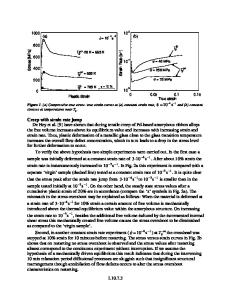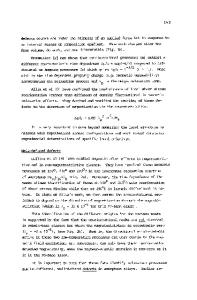Volume and Enthalpy Relaxation in Bulk Metallic Glasses
- PDF / 149,074 Bytes
- 4 Pages / 595 x 842 pts (A4) Page_size
- 50 Downloads / 371 Views
1048-Z02-03
Volume and Enthalpy Relaxation in Bulk Metallic Glasses Osami Haruyama Physics, Tokyo University of Science, 2641 Yamazaki, Noda, 278-8510, Japan ABSTRACT Volume and enthalpy relaxation processes in a sub-Tg region were investigated by density and enthalpy experiments for bulk Pd-P based and Zr-based metallic glasses. Most of glasses except for a Pd40Ni40P20 glass exhibited a single relaxation process for both volume and enthalpy relaxations and the relaxation process was well described by a stretched exponential relaxation function, Φ(t)=exp{-(t/τ)β}, with a Kohlrausch index β less than 1. The as-quenched sample was pre-annealed in a supercooled liquid region to homogenize the density fluctuation quenched in an as-quenched state. Then the slight retardation of onset time of relaxation appeared in case of volume relaxation. The proportionality between enthalpy change ∆H and volume change ∆v during relaxation was good for Pd42.5Cu30Ni7.5P20 glass within experimental error.
INTRODUCTION Recently, the study on structural relaxation in a sub-Tg region has been developed by the use of bulk metallic glass. Various physical properties like viscosity [1], positron life-time [2,3], enthalpy [4,5] and density [6,7] show that the relaxation process has a spectrum of relaxation times and is well described by a stretched exponential relaxation function with a Kohlrausch exponent less than 1. Although the structural relaxation gives rise to change in physical property, the relationship between structural relaxation and physical change is not exactly interpreted, so far. The density is considered to connect most directly to the structural relaxation and easily to interpret the change accompanying with structural relaxation. The structural relaxation process has been analyzed frequently within free volume theory. The free volume was defined as an excess volume to explain diffusion of molecules and atoms in equilibrium liquids [8]. Thereafter, the free volume theory was developed to interpret the glass transition and structural relaxation in a glass solid [9,10]. Then, the glass structure is considered to be composed of solid-like clusters and liquid-like clusters, relating to structural relaxation [10]. In present study, we will exhibit mainly volume relaxation behavior examined by density experiments and enthalpy relaxation behavior calculated from heat capacity curves measured, and we will examine whether there exists a close relationship between volume and enthalpy relaxations, which is assumed implicitly by free volume theory.
Experimental Procedures Rod-like samples with a size of 8 mm in diameter were prepared by water quenching for Pd-based glasses and tilted copper mold casting for Zr-based glasses. The amorphous nature of sample was confirmed by X-ray diffraction and differential thermal analysis (DTA). A disk-like sample piece with a weight of about 2 g was cut from glass rod for density experiments. Density experiments were carried out at room temperature after relaxing the sample at a given temperature fo
Data Loading...











